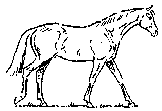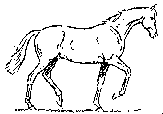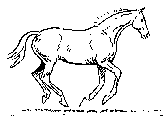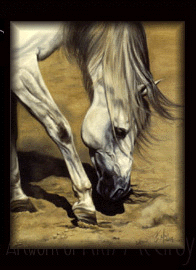The Basic Movements
















 Walk-Walking is the least interesting of a horse's gaits but provides the rider the opportunity to get use to the horse. For a new rider, walking allows them to practice the correct seat and hand positions. It is the most relaxing of a horse's movements and good for generating confidence in both horse and rider.
Walk-Walking is the least interesting of a horse's gaits but provides the rider the opportunity to get use to the horse. For a new rider, walking allows them to practice the correct seat and hand positions. It is the most relaxing of a horse's movements and good for generating confidence in both horse and rider.
 Trot-Trot is a two beat pace, therefore most riders rise in the saddle to the trot this is known as rising trot. Rising trot consists of an up-down motion of the riders seat in time with the horse's beat. The riders body should be slightly forward but without hunching the shoulders. On the first beat, let the action of the horse throw your seat up and forward. On the second beat allow your seat return to the saddle, ready for the next movement. Let your body move naturally with the horse.
Trot-Trot is a two beat pace, therefore most riders rise in the saddle to the trot this is known as rising trot. Rising trot consists of an up-down motion of the riders seat in time with the horse's beat. The riders body should be slightly forward but without hunching the shoulders. On the first beat, let the action of the horse throw your seat up and forward. On the second beat allow your seat return to the saddle, ready for the next movement. Let your body move naturally with the horse.
 Canter- Canter is the most enjoyable of the four movements. It is a three beat motion which the rider normally sits. When changing to canter the rider should lean forward slightly with weight evenly distributed. When in canter the rider must mantain as much contact with the saddle as possible by rocking forwards and backwards with the horse. A shorter rein is called for at canter so the horse remains collected and keeps an even movement.
Canter- Canter is the most enjoyable of the four movements. It is a three beat motion which the rider normally sits. When changing to canter the rider should lean forward slightly with weight evenly distributed. When in canter the rider must mantain as much contact with the saddle as possible by rocking forwards and backwards with the horse. A shorter rein is called for at canter so the horse remains collected and keeps an even movement.
 Gallop-The gallop is the fastest movement. It is a four beat movement. When changing from canter. The more advanced rider leans forward off the saddle and grips with thighs and lower legs. This minimizes the bouncing in the saddle and mantains balance. At this speed it is important that you allow the horses head movement. To slow the horse, pull back on the reins a little and slowly come back into the saddle. Once in the saddle the horse will slow to a canter because the horse will find it uncomfortable to gallop with the rider's full weight in the saddle.
Gallop-The gallop is the fastest movement. It is a four beat movement. When changing from canter. The more advanced rider leans forward off the saddle and grips with thighs and lower legs. This minimizes the bouncing in the saddle and mantains balance. At this speed it is important that you allow the horses head movement. To slow the horse, pull back on the reins a little and slowly come back into the saddle. Once in the saddle the horse will slow to a canter because the horse will find it uncomfortable to gallop with the rider's full weight in the saddle.

E-mail
jenniemay@hotmail.com
Home / Pervious / Next
 Walk-Walking is the least interesting of a horse's gaits but provides the rider the opportunity to get use to the horse. For a new rider, walking allows them to practice the correct seat and hand positions. It is the most relaxing of a horse's movements and good for generating confidence in both horse and rider.
Walk-Walking is the least interesting of a horse's gaits but provides the rider the opportunity to get use to the horse. For a new rider, walking allows them to practice the correct seat and hand positions. It is the most relaxing of a horse's movements and good for generating confidence in both horse and rider. Trot-Trot is a two beat pace, therefore most riders rise in the saddle to the trot this is known as rising trot. Rising trot consists of an up-down motion of the riders seat in time with the horse's beat. The riders body should be slightly forward but without hunching the shoulders. On the first beat, let the action of the horse throw your seat up and forward. On the second beat allow your seat return to the saddle, ready for the next movement. Let your body move naturally with the horse.
Trot-Trot is a two beat pace, therefore most riders rise in the saddle to the trot this is known as rising trot. Rising trot consists of an up-down motion of the riders seat in time with the horse's beat. The riders body should be slightly forward but without hunching the shoulders. On the first beat, let the action of the horse throw your seat up and forward. On the second beat allow your seat return to the saddle, ready for the next movement. Let your body move naturally with the horse. Canter- Canter is the most enjoyable of the four movements. It is a three beat motion which the rider normally sits. When changing to canter the rider should lean forward slightly with weight evenly distributed. When in canter the rider must mantain as much contact with the saddle as possible by rocking forwards and backwards with the horse. A shorter rein is called for at canter so the horse remains collected and keeps an even movement.
Canter- Canter is the most enjoyable of the four movements. It is a three beat motion which the rider normally sits. When changing to canter the rider should lean forward slightly with weight evenly distributed. When in canter the rider must mantain as much contact with the saddle as possible by rocking forwards and backwards with the horse. A shorter rein is called for at canter so the horse remains collected and keeps an even movement. Gallop-The gallop is the fastest movement. It is a four beat movement. When changing from canter. The more advanced rider leans forward off the saddle and grips with thighs and lower legs. This minimizes the bouncing in the saddle and mantains balance. At this speed it is important that you allow the horses head movement. To slow the horse, pull back on the reins a little and slowly come back into the saddle. Once in the saddle the horse will slow to a canter because the horse will find it uncomfortable to gallop with the rider's full weight in the saddle.
Gallop-The gallop is the fastest movement. It is a four beat movement. When changing from canter. The more advanced rider leans forward off the saddle and grips with thighs and lower legs. This minimizes the bouncing in the saddle and mantains balance. At this speed it is important that you allow the horses head movement. To slow the horse, pull back on the reins a little and slowly come back into the saddle. Once in the saddle the horse will slow to a canter because the horse will find it uncomfortable to gallop with the rider's full weight in the saddle.